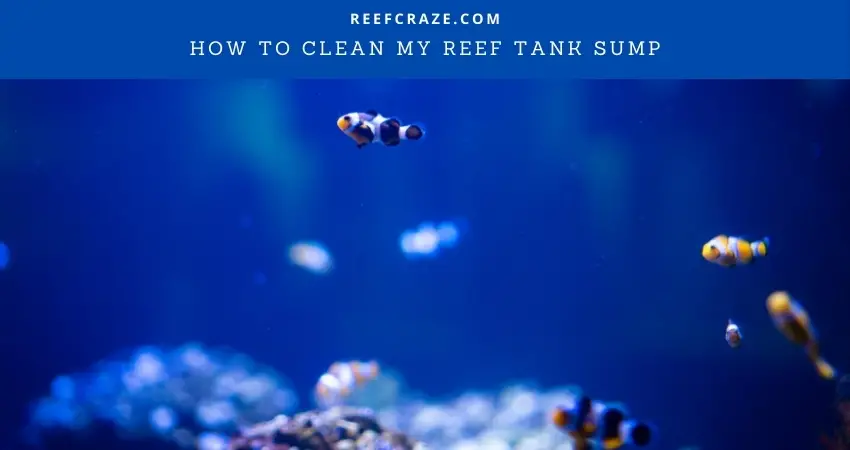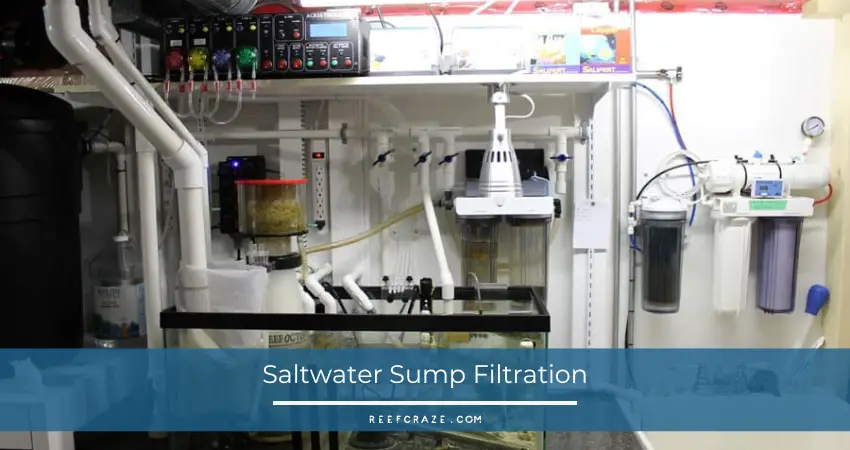Sumps are saviors for fish tanks. I realized that after I got mine. It helps to keep the tank environment stable and allows the fish to thrive. But as time passed and the tank started getting dirty, I had one thing in my mind: how to clean my reef tank sump.
You can clean a reef tank sump with Shop-Vac, siphoning out the detritus, or using standard cleaning methods. The way to clean a tank sump depends on how long you have gone without cleaning or what way you prefer.
But what is the right way to clean reef tank sump, or how often should you do it? The answer is right here in this article.
How To Clean My Reef Tank Sump?
As I mentioned, the cleaning method will depend on how much time has passed since your last cleaning. Nevertheless, there are various methods for different cleaning schedules.

Weekly Sump Cleaning
Weekly cleaning is the primary part of maintaining a fish tank. So, while doing that, cleaning up the sump can boost your tank environment and fish health.
During weekly cleaning, make a note of cleaning the following parts:
- Filter socks
- Front glass/acrylics
- Emptying the protein skimmer cups
Filter Socks
Generally, filter socks work as mechanical filters for any fish tank. They are highly effective at removing debris and other particles. So, if you do not clean and change the filter socks, they will start clogging the tank.
Here is how you can clean the filter socks:
- First, remove the sock from the tank and place it in a bucket.
- Turn the sock upside down.
- Place the sock inside the washer and turn the washer on for hot and delicate wash.
- After the washing is done, remove the sock from the washer and air dry it.

Front Acrylics/Glass
The next thing you need to clean weekly is the front acrylic or glass of the sump. Use a sponge or a scraper to clean the glass or acrylic.
You can use a paper towel to clean the front area of the sump. Later, use a dry towel or paper towel to dry the glass.
Emptying Protein Skimmer Cups
Empty the protein skimmer cups only if you think they need cleaning. Many of these cups have a drain plug to empty them automatically.
If not, you can connect the pipes to larger containers to keep them from cleaning frequently. Not emptying the skimmer cups from time to time can lead to overflow issues.
Monthly Sump Cleaning
You can clean the tank’s organic wastes every month. You don’t want to remove all of them from the tank as some of these waste bacteria improve tank health. But here is what you can do for monthly sump cleaning:
- Remove organic wastes
- Clean the back and sidewalls
- Rinse off the sponges
- Clean and change filter media
Remove Organic Wastes
There are two ways to remove the built-up organic wastes at the bottom of your reef tank. One is to take the turkey baster to low-flow areas. Another one is to remove them manually.
Using the turkey baster is suitable for easy cleaning. You take it to the low-flow areas of the tank and kick the wastes to get them into the water column. In this way, your sump filtration system will quicken.
Another way to remove waste built-up is using line pumps and filter socks. You can clean the sump manually by using those.
The inline pump’s hose pulls water from one end and releases it from another. You can use one end of the hose to intake the detritus from the sump and let the other end release them into filter socks. The socks will catch the detritus easily. This method helps return the sump water into the sump.
Clean Back And Side Walls
Clean your tank sump’s back and side walls as though your life depends on it. Well, at least your tank fish’s lives do.
Use tools, such as sponges or scrapers that are glass and acrylic friendly. If there is any sponge filter between the baffles, you need to spray them off.
Clean And Change Filter Media
Most tank filter media needs frequent changing. It depends on what type of media you have in your tank. Based on that, you need to clean and change your tank media every month.
Quarterly Sump Cleaning
You can do a quarterly sump cleaning every three months or so. This time, pay attention to the sump parts, such as media reactors, protein skimmer, return pump, and other equipment.
Remove the equipment and disassemble them this time for better cleaning. If there are many build-ups this time, place the parts in vinegar and water mixture to soak for a couple of hours before washing them.
Sometimes, people overlook cleaning the heater. But trust me, it needs your attention as well. Watch out for chalky build-ups. If there is any, you can clean them manually or use vinegar and water to remove them.
Cleaning Sump When Needed
What happens when you don’t clean your reef tank sump for a long time? I don’t know about you, but I can already picture something that will need hours of sweaty work.
When you neglect cleaning the sump for around a year or more, organic wastes start building up like crazy. Thick layers of sludges will keep accumulating at the bottom of the tank. Not to mention the growing algae, nitrites, and ammonia that are already thriving in the water.
If you end up in such a situation, you need to deep clean the sump. It means you have to drain the entire tank sump, take out all the equipment and clean out the wastes.
I know that sounds tiring but refreshing at the same time. However, deep-cleaning a sump has a drawback. This type of cleaning eliminates all necessary bacteria, along with the harmful ones. So it can create a negative impact on your tank environment.
Your Own Cleaning Schedule
It is silly to think that everyone will have the same amount of time for sump cleanup. But do make a cleaning schedule whenever you feel is convenient for you.
Keep an eye on the sump visibility and look for any sign of clogging, discoloration, or rise of water level. These are the signs that scream that the sump needs immediate cleaning.
I would recommend keeping a cleaning log to remember when to clean the sump again. It will give you some time to plan for a schedule.
Frequently Asked Questions
Why Should I Have A Tank Sump?
It is not mandatory to have a sump in a fish tank. However, if you add one, you will receive the following benefits from it.
1. Tank sumps are excellent for setting up filtration media. You can place biological, chemical, and mechanical media in it.
2. You can also place the heater, protein skimmers, other equipment in it and save them from hanging outside the fish tank.
3. It adds tank water volume and helps improve the tank environment.
4. It boosts water circulation and aeration.
How Often Do I Need To Clean My Reef Tank Sump?
It is wise to clean your reef tank sump once a week. This saves you from tiring hours of cleaning when you perform yearly cleanups. Change about 10% of water to prevent algae and other harmful bacteria from accumulating.
Clean the skimmer cups, filter media, and walls at least once a month. The skimmer cups, filter socks, and return pumps need a better cleaning once every three-four months.
How Often Should I Change The Filter Socks In The Sump?
Just like a sump, the frequency of cleaning filter socks will differ from person to person. It will also depend on how often the socks are getting dirty. But it is safe to clean or change the filter socks every 3-4 days or as soon as you start noticing discoloration.
Can I Keep Fish In A Sump?
Yes, you can keep fish in a sump. But I will say that sumps are not exactly a safe place for fish to live in. If you keep fish in the sump, there is a chance that it will jump into the skimmer or the return pump. So I would not recommend keeping fish in the tank sump.
What Size Aquarium Sump Do I Need?
An aquarium sump should be 20% of the tank size. But sometimes, exceptions can be made because you may need a bigger sump to fit in the tank stand.
Besides, using a large sump helps increase water volume and tank stability. Make sure the sump size leaves enough gap above the filter media.
Last Words
Tank sumps are incredible when it comes to having some surface space. It provides you with enough space to set up and hide your tank equipment. But as time passes, it becomes necessary to clean the sump from time to time.
And once I have learned how to clean my reef tank sump properly, maintaining it has become a lot easier. However, the longer you go without taking care of your reef tank sump, the more challenging it gets to clean it up later.
